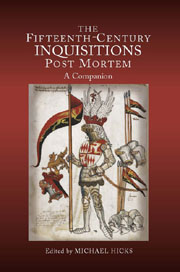Book contents
- Frontmatter
- Contents
- List of Tables and Figures
- List of Contributors
- Preface
- Glossary
- Abbreviations
- 1 Introduction
- 2 Crossing Generations: Dower, Jointure and Courtesy
- 3 The Lesser Landowners and the Inquisitions Post Mortem
- 4 Tales of Idiots, Signifying Something: Evidence of Process in the Inquisitions Post Mortem
- 5 The Value of Fifteenth-Century Inquisitions Post Mortem for Economic and Social History
- 6 ‘Notoriously Unreliable’: The Valuations and Extents
- 7 The Descriptions of Land Found in the Inquisitions Post Mortem and Feet of Fines: A Case Study of Berkshire
- 8 Re-assessing Josiah Russell's Measurements of Late Medieval Mortality using the Inquisitions Post Mortem
- 9 A Great Historical Enterprise: The Public Record Office and the Making of the Calendars of Inquisitions Post Mortem
- 10 Writs and the Inquisitions Post Mortem: How the Crown Managed the System
- 11 ‘Thrifty Men of the Country’? The Jurors and Their Role
- 12 Place-Names and Calendaring Practices
- Index
2 - Crossing Generations: Dower, Jointure and Courtesy
Published online by Cambridge University Press: 05 February 2013
- Frontmatter
- Contents
- List of Tables and Figures
- List of Contributors
- Preface
- Glossary
- Abbreviations
- 1 Introduction
- 2 Crossing Generations: Dower, Jointure and Courtesy
- 3 The Lesser Landowners and the Inquisitions Post Mortem
- 4 Tales of Idiots, Signifying Something: Evidence of Process in the Inquisitions Post Mortem
- 5 The Value of Fifteenth-Century Inquisitions Post Mortem for Economic and Social History
- 6 ‘Notoriously Unreliable’: The Valuations and Extents
- 7 The Descriptions of Land Found in the Inquisitions Post Mortem and Feet of Fines: A Case Study of Berkshire
- 8 Re-assessing Josiah Russell's Measurements of Late Medieval Mortality using the Inquisitions Post Mortem
- 9 A Great Historical Enterprise: The Public Record Office and the Making of the Calendars of Inquisitions Post Mortem
- 10 Writs and the Inquisitions Post Mortem: How the Crown Managed the System
- 11 ‘Thrifty Men of the Country’? The Jurors and Their Role
- 12 Place-Names and Calendaring Practices
- Index
Summary
Land was transferred between generations on the death of the deceased tenants according to the rules of inheritance discussed in the Introduction. This chapter is not concerned with who it was who inherited, by what title, or what it was that they inherited. It also specifically excludes the inheritance of moveable goods (chattels) that were bequeathed by will. Actually the process of succession was less tidy and immediate than the opening statement suggests. This was because the deceased tenant generally left behind a spouse, a widow or widower, who had to be supported from portions of the estate. The legitimate expectations of the heir(s) were therefore delayed.
Such complications stemmed from marriage, which was virtually universal in late medieval England. Marriage was ordained by God for the procreation of children – legitimate children – and the avoidance of such sins as fornication (sex outside wedlock), adultery (sex with other people's spouses), and incest (sex with relatives within the prohibited degrees). Outside the clergy virtually everyone married at least once. Almost all weddings were arranged, amongst the aristocracy as well as the peasantry, by parents, by elder brothers, by guardians in the case of wards, or by the couple themselves. Often these were child matches. The selection of partner was a hard-headed business that gave great weight to the finances, connections, and political interests of the contracting partners. Most matches were struck with social equals within their social circles, people whom they knew, did not dislike, liked, even occasionally loved.
- Type
- Chapter
- Information
- The Fifteenth-Century Inquisitions 'Post Mortem'A Companion, pp. 25 - 46Publisher: Boydell & BrewerPrint publication year: 2012



